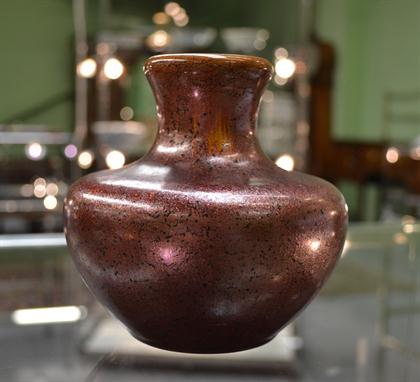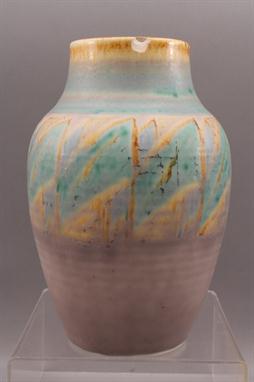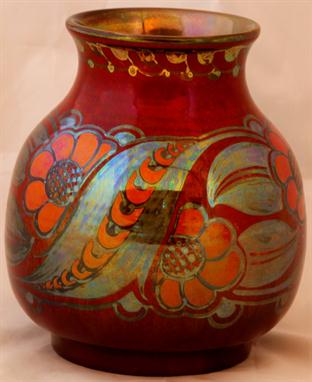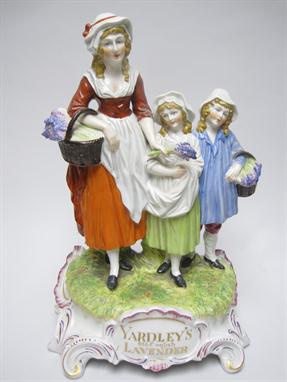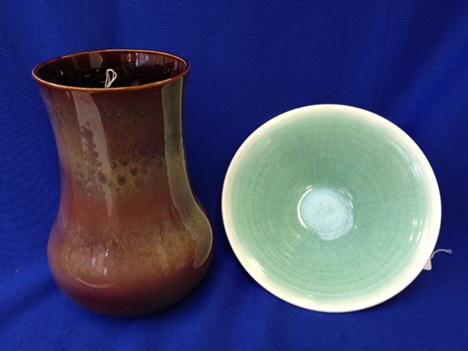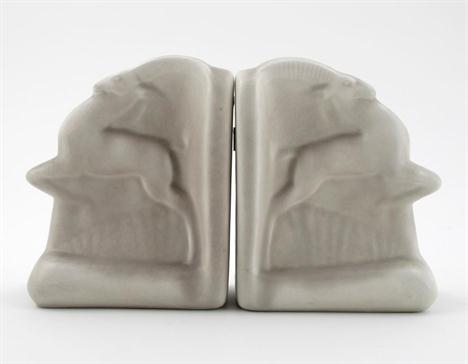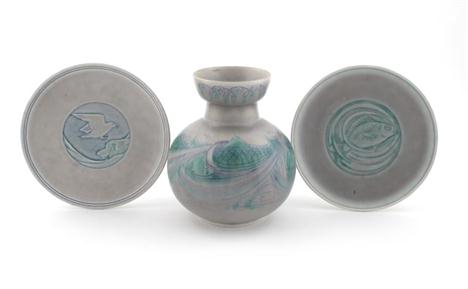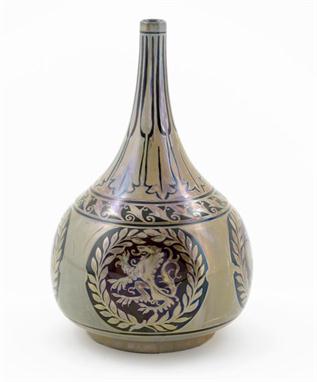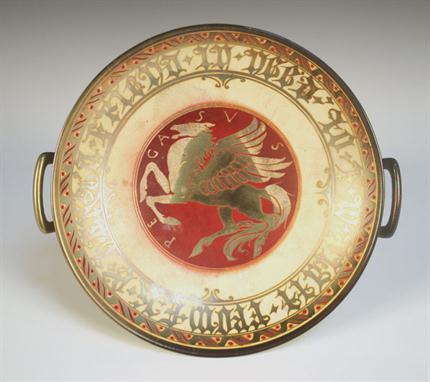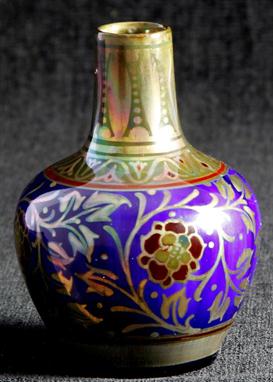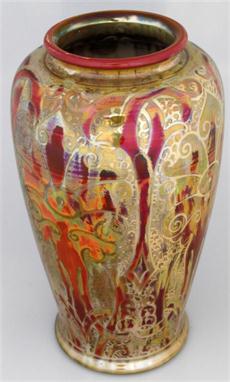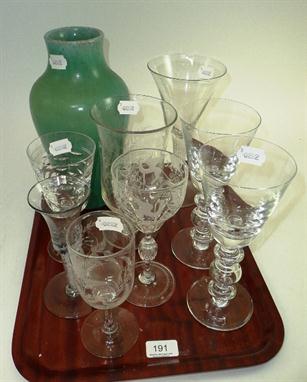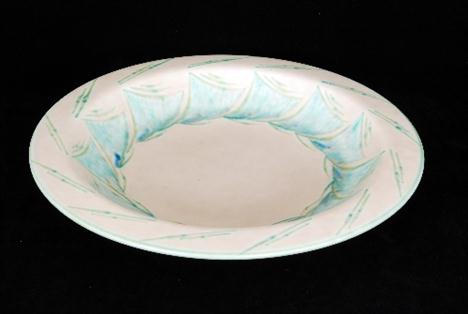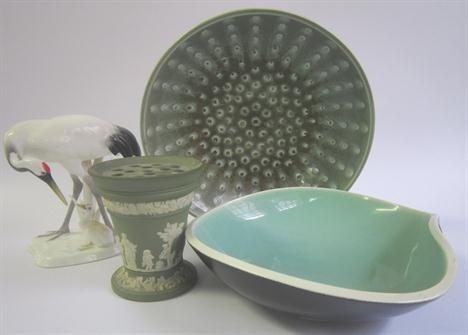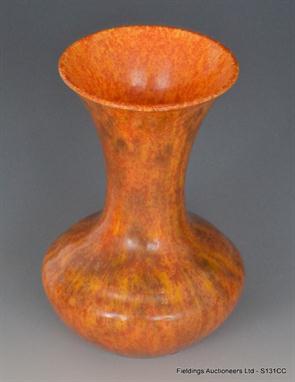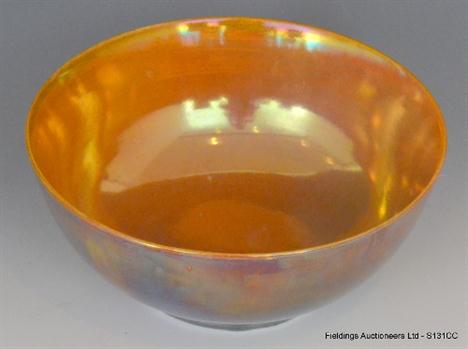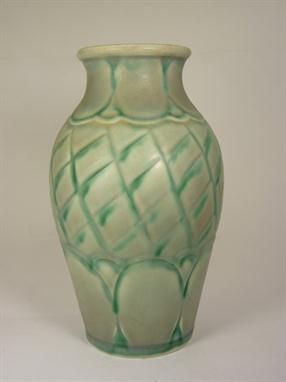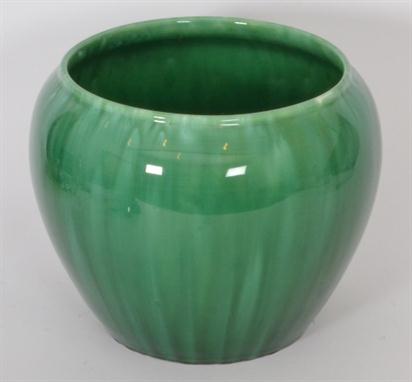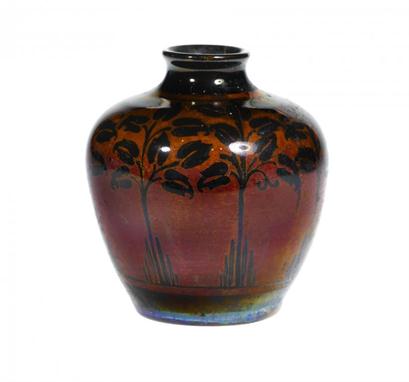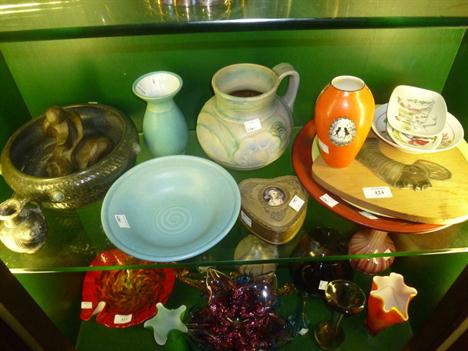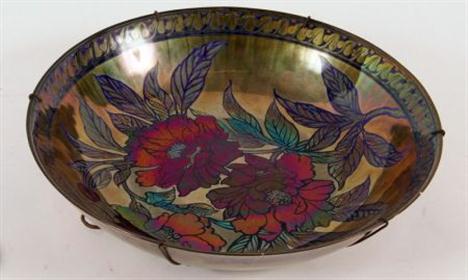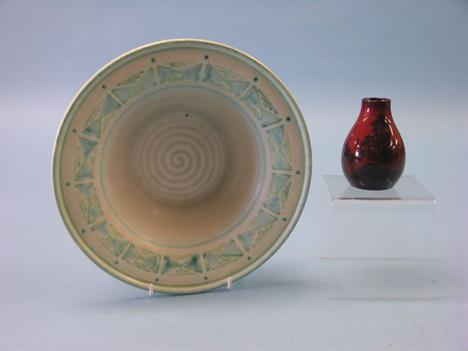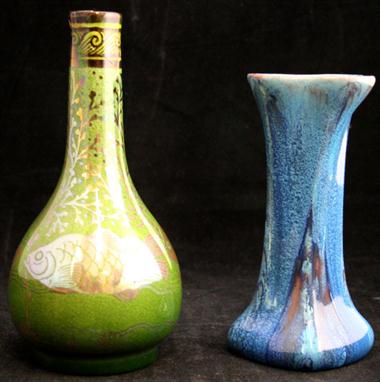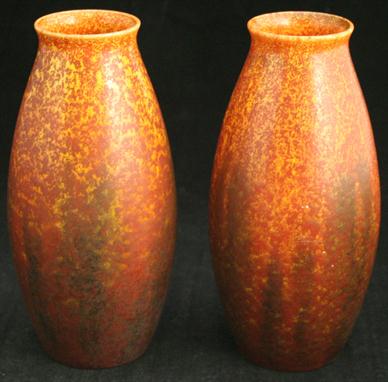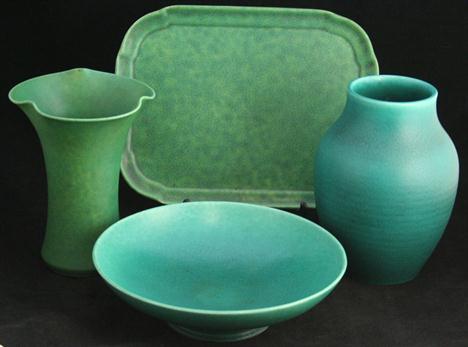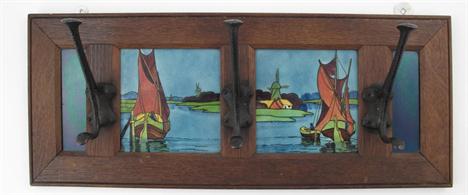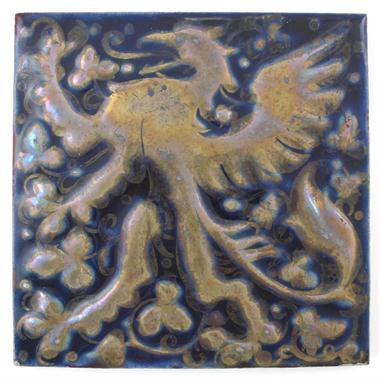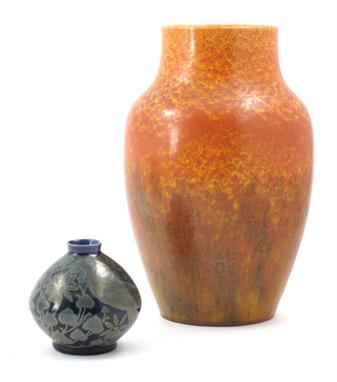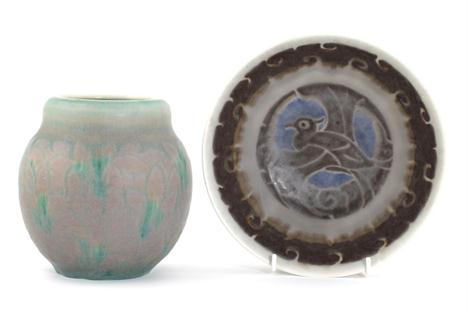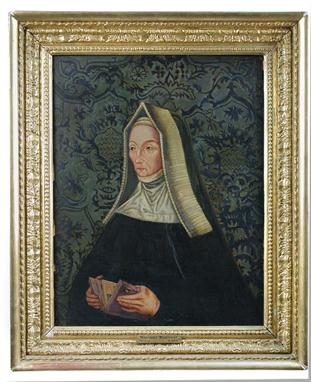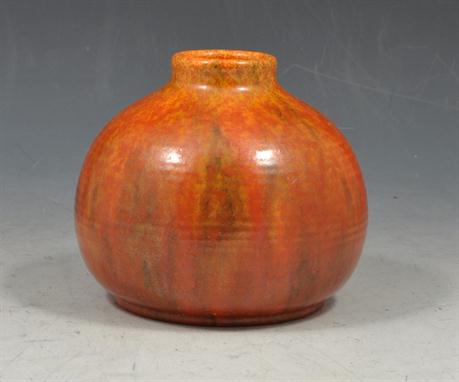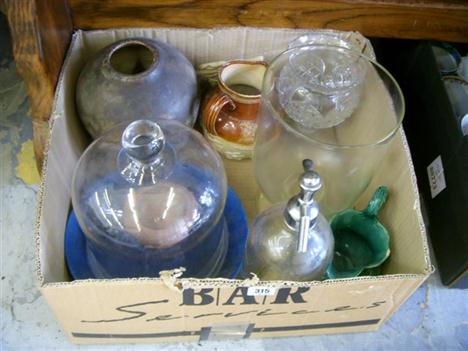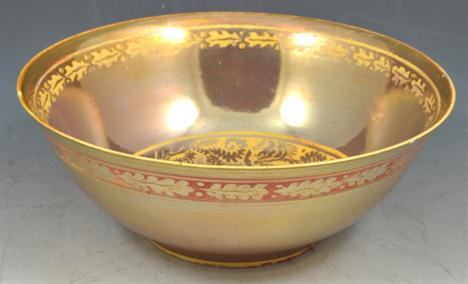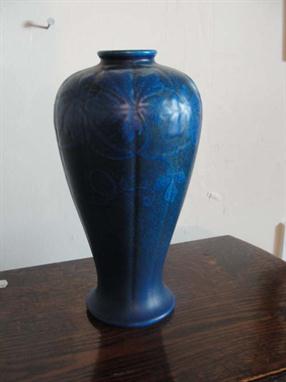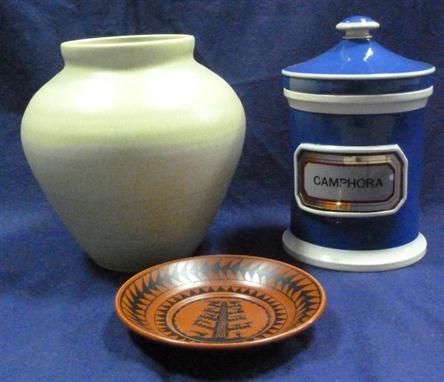We found 1543 price guide item(s) matching your search
There are 1543 lots that match your search criteria. Subscribe now to get instant access to the full price guide service.
Click here to subscribe- List
- Grid
-
1543 item(s)/page
A Pilkingtons Royal Lancastrian lustre vase of bulbous form, decorated with stylised flowerheads and foliate on a ruby ground, impressed factory marks no.3255 and signature for William S Mycock, impressed initials and potted by E T Radford, with original price label to base, height 18cm (illustrated)
A Pilkington`s Lancastrian lustre pottery two handled centrepiece, circa 1910, decorated by Gordon Forsyth, monogrammed, the circular top with a titled depiction of `Pegasus` against a ruby ground within cream framing with inscription `To F.W. Platt From E.K. & H.B.K 1910 A Friend In Deed`, the green glazed underside raised on a spreading circular foot, impressed and painted factory marks to foot, diameter approx 27cm (one handle repaired, light staining).
A Pilkington`s Lancastrian lustre pottery vase, circa 1920, the small compressed bulbous body with flared neck, decorated by Richard Joyce, monogrammed, with fish amidst weed and bubbles against a green/dark red ground, impressed factory marks to base with painted monogram, height approx 9.5cm.
Commemorative Medal George, Prince Regent - Lancastrian Education System - Silvered MedalCirca 1812 AD. Obv: profile bust with PATRON OF THE ROYAL LANCASTRIAN SYSTEM legend. Rev: Prince of Wales feathers with G(eorge) P(rince) R(egent) below and THE WISE SON OF A PIOUS FATHER legend. BHM i, 752. 7.16 grams. Joseph Lancaster (1778-1838) was the founder of the Lancasterian system of education. He opened a school at Borough Road, south London, in 1798 and divided it into small classes, each under a monitor; a group of these classes was supervised by a head monitor. In this way, and by using mechanical methods of learning, he could accommodate 1,000 boys. George III promised him his support in 1805. The King’s patronage and the consequent support given to Lancaster by his sons, the Prince Regent and the Dukes of Sussex and Kent, transformed the society into one of the nation’s most useful institutions. Before the government took an interest in education, it provided rudimentary schooling for hundreds of thousands of poor children.Very fine. Rare.Starting Price: £70
A Royal Lancastrian dish, 20th century, of circular form, with cylindrical interior, decorated with linear and scrolling pattern, bearing maker`s marks under base, diameter 22 cm; Andrew Hill, a black studio pottery vase, late 20th/early 21st century, of classical form, the flared top leading to slender short neck and oval body, bears maker`s marks under base, height 20 cm; a Venezuelan red studio pottery vase, late 20th/ early 21st century, of classical form, the slightly ribbed body decorated in variegated red, bears maker`s marks under base, height 21 cm; together with a miscellaneous quantity of studio pottery items to include vases, bowls, plates and dishes, of various forms, shapes and sizes, (a lot).
A Pilkington`s Royal Lancastrian onion form lustre vase, decorated with stylised fish between foliate, by Richard Joyce, impressed factory marks and no.2364 to base, height 17cm (af), together with a Pilkington`s Royal Lancastrian blue glazed vase of twisted square form, impressed factory marks and no.2346 to base, height 14.5cm (af)
Four pieces of Pilkington`s Royal Lancastrian, comprising ovoid form vase, impressed factory marks and no.200 to base, height 21cm, flared cylindrical vase, impressed factory marks and no.2143A to base, height 20cm, footed circular bowl, impressed factory marks to base, diameter 26cm, square tray, impressed factory marks to base, length 31.5cm
A Shapland & Petter, Raleigh tray, inset with three Pilkington`s Lancastrian tiles, designed by Lewis F Day, each tile slip decorated with flower sprays, in yellow and green on a white ground, inside green spacer tile border applied Raleigh ivorine label tray 67cm. wide Literature Daryll Bennett, Shapland & Petter Ltd of Barnstaple page 84 plate 5.35 for a comparable tray. A J Cross Pilkington`s Royal Lancastrian Pottery and Tiles, page 13 colour plate XI for comparable tiles.
A Pilkington`s Lancastrian tile, decorated in low relief with a heraldic dragon, in copper lustre on a blue ground impressed P to reverse, minor glaze nicks 15.5cm. square Literature A J Cross Pilkington`s Royal Lancastrian Pottery & Tiles Richard Dennis, page 23 plate 14 for a tile with a comparable dragon in a shield motif
English School, Portrait of Margaret Beaufort, Countess of Richmond (1441-1509) oil on panel, 56 x 44cm (21.84 x 17.16in). Provenance: The Hon Hugh Lawson Johnson, Melchbourne Park, Bedfordshire, thence by descent. Margaret Beaufort was mother of Henry VII, the Founder of St John`s College and Christ`s College, Cambridge. She was born at Bletsoe Castle, Bedfordshire. Sir John St John was her half-brother. The original panel was, in 1904, in the possession of the 16th Baron St John at Melchbourne - copied from the original painting by Wilfred B Egan in December, 1904. Lady Margaret`s royal status was derived illegitimately from her paternal great grandfather, John of Gaunt, Duke of Lancaster – the fourth son of Edward III. Her father, John Beaufort, Duke of Somerset, was a disgraced military commander who died shortly before she was one year old. Subsequently, Lady Margaret was placed as a ward under the Marquess of Suffolk, who betrothed young Margaret to her son at the age of six. In 1453, the Lancastrian Henry VI dissolved the marriage and decided that she should instead marry Edmund Tudor, the son of Catherine of Valois, the Queen of Henry V, reinforcing the Lady`s royal status. Margaret Beaufort was the progenitor of the Tudor line. By the time Lady Margaret gave birth to Henry Tudor (at the age of 13) she was already a widow. After the murder of Henry VI in 1471 and the accession of the Yorkist Edward VI, she fled to France with her son, the next male in the Lancastrian family line. For further safety, Lady Margaret married Thomas, 2nd Baron Stanley, in 1472, a powerful figure and a Yorkist supporter at that time. Margaret accepted the Yorkist supremacy for the remainder of Edward`s reign, however after the accession of Richard III and the murder of the Princes in the Tower, she began to plot their overthrow and push for her son`s succession. Her involvement and the failure of the Duke of Buckingham`s rebellion in 1484 saw her estate handed over to the control of her husband, who also agreed to be her gaoler. Despite this, Lady Margaret continued to push for Richard`s overthrow and was instrumental in negotiating the marriage between her son and Elizabeth of York, an important match as it signified the union of the two houses of York and Lancaster, further increasing Henry`s claim to the throne. Lady Margaret`s role changed after Henry`s victory over Richard at the Battle of Bosworth Field in 1485. She began to sign her letters `Margaret R` and was granted large households in London and Northamptonshire, where she was effectively Henry`s Deputy in the East Midlands. She was also an established author and translator, publishing many religious tracts and patronising a number of centres of learning, such as St. John`s College, Cambridge. Sir John St John (1473-1512) was Chamberlain to Margaret, Countess of Richmond, and Executor of her Estate. Towards the end of her life, she became increasingly religious and devoted herself to a life of prayer. The present painting is a copy of the prototype in the National Portrait Gallery which dates from the 16th Century, and of which there are many copies and derivations
-
1543 item(s)/page
